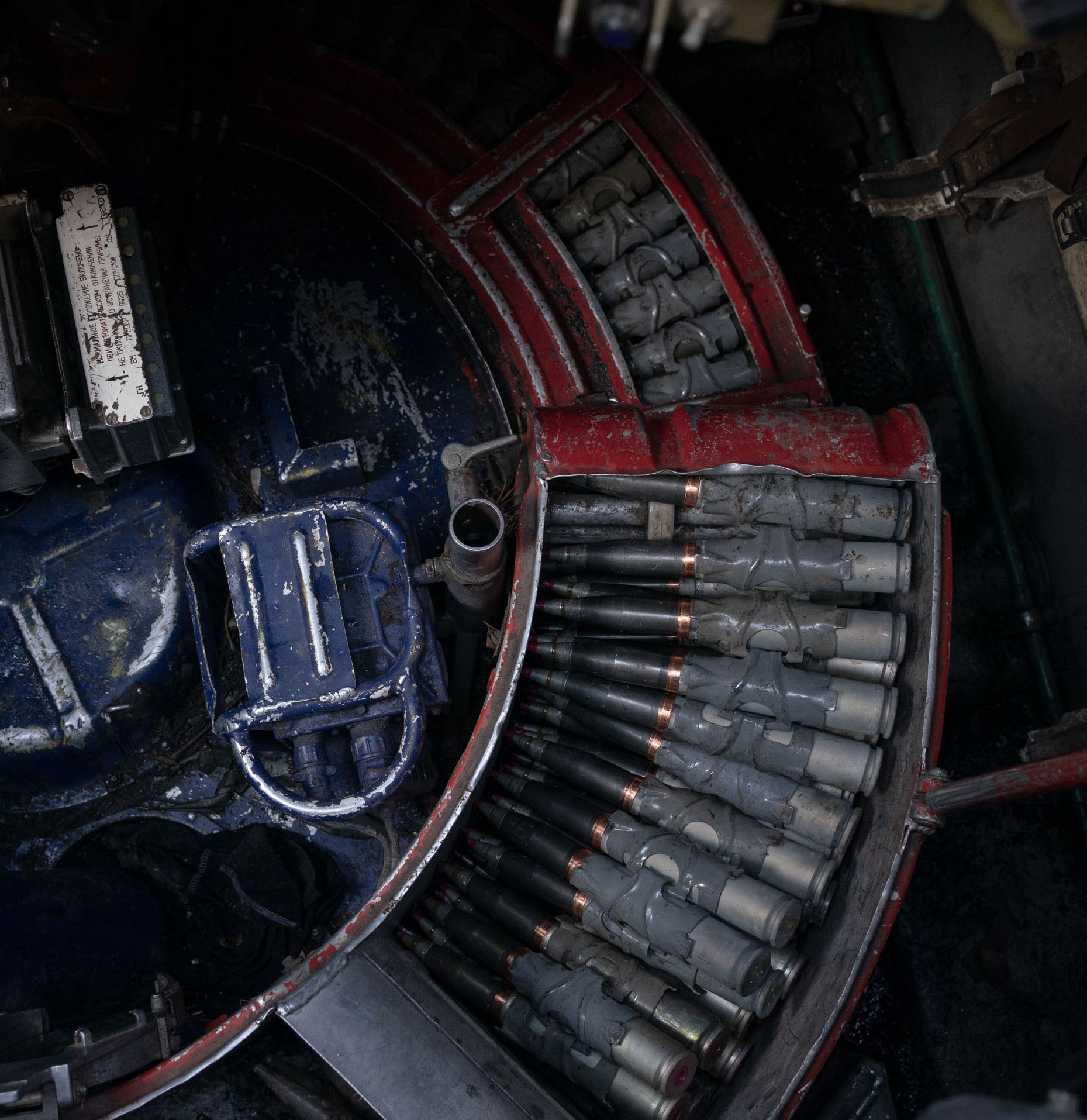This winter, after a protracted impasse along the frontlines, the war in Ukraine began a new phase with its own distinctive rhythm. It has been defined in recent days by the dramatic pattern of drone strikes deep inside Russian territory. On most mornings, the world now sees the results of such strikes in news reports and images from Russia: columns of fire rising over a fuel depot in the region of Bryansk, an oil terminal near St. Petersburg, and targets in other Russian towns and regions, from Oryol and Tula to Belgorod.
What the world does not see of these weapons is the way they are deployed, usually in the dead of night at secret bases in Ukraine. They are so closely guarded that, apart from the soldiers who operate them, only a few civilian engineers are usually allowed to observe the launches, taking careful notes and measurements of the way the weapons function, the way the troops use them and any mishaps that take place along the way.
“We don’t have time to test these things on the firing range,” says Oleksandr Kamyshin, Ukraine’s Minister of Strategic Industries, who oversees the nation’s military industry and often goes himself to see its newest weapons on the launchpad. “We test them in combat,” he tells TIME. “So we have to be there, making adjustments and improvements along the way.”
Such experiments, conducted with oversight from Kamyshin and his ministry, are likely to define the next stage of this war. On orders from President Volodymyr Zelensky, the Ukrainians have begun trying to ease their reliance on Western arms by manufacturing more of their own. Nearly all of the recent strikes against targets in Russia have come not from foreign stockpiles, Kamyshin says, but from Ukrainian factories and clandestine workshops.
Ukraine’s ability to produce enough arms for its own military will be central to its current strategy for defeating the Russians. As Zelensky put it in a recent interview with the Associated Press: “This is the way out.”
But, for the strategy to work, Ukraine will need overcome a range of challenges. It will have to marry its old and battered arms industry to advanced weapons designs and capabilities from western allies, especially those of the United States. During his most recent visits to the White House, once in September and again in December, Zelensky asked President Joe Biden not only for financial and military aid but, no less urgently, the licenses Ukraine needs to produce and repair American weapons. “Give us these opportunities,” he recalled telling Biden after one of these visits. “And we will build.”
In theory, the plan could work. Since Zelensky’s September visit to the Oval Office, TIME has interviewed nearly a dozen current and former officials and executives in Kyiv and Washington to learn what it would take for Ukraine to produce enough weapons to fight the war. On the American side, the collaboration is possible, if hard. Under U.S. law, Biden has the power to grant licenses that would help kick-start domestic Ukrainian weapons production without the approval of the U.S. Congress. Still, the decision would need to go through a byzantine approval process within the U.S. government and, crucially, Ukraine would need billions of dollars in aid to revitalize its weapons industry.
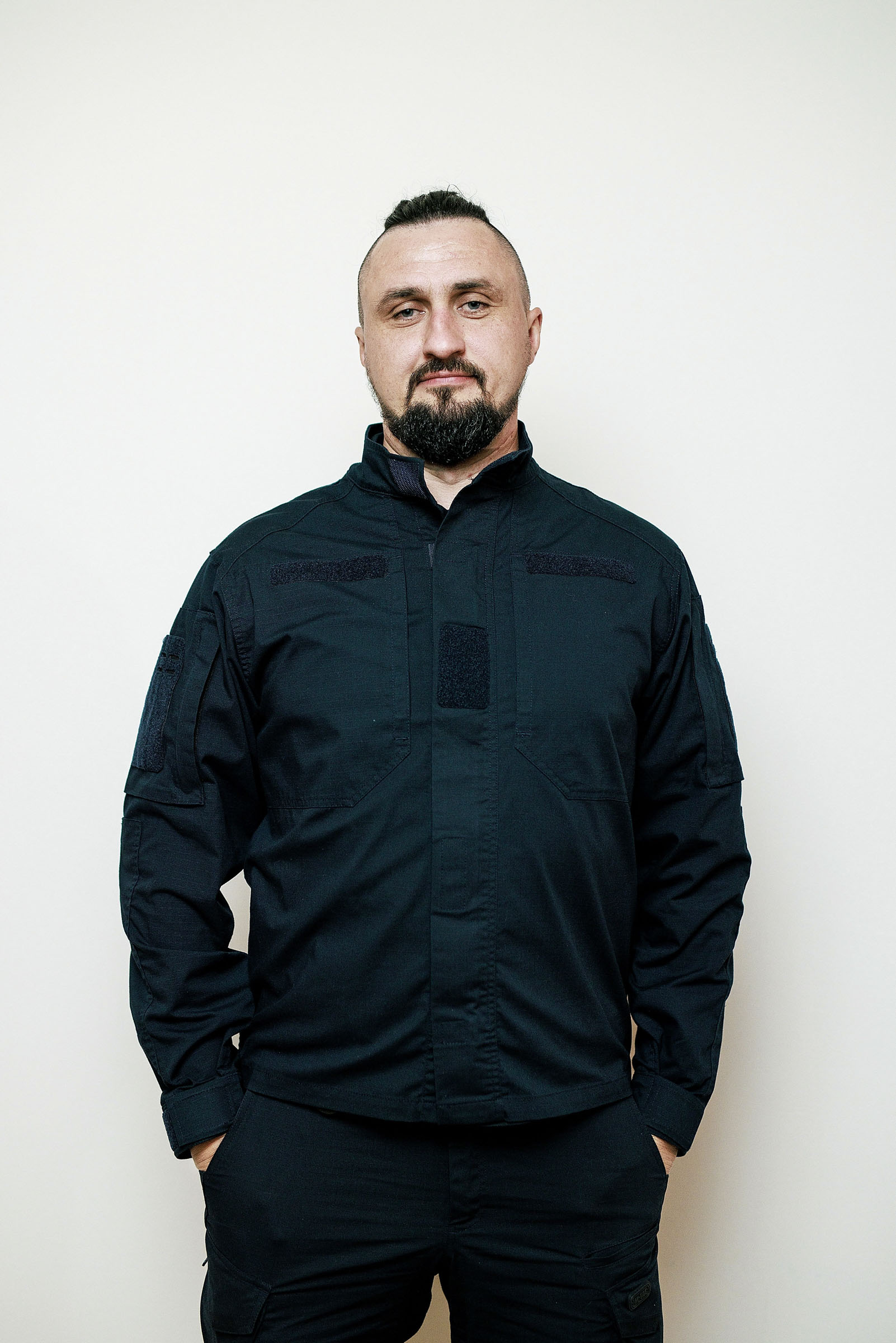
Even harder is the work required in Ukraine. Once an engine of the Soviet war machine, Ukraine’s military industry has hundreds of factories and tens of thousands of workers at the ready. But they have been pummeled by Russian missile strikes and have atrophied through decades of mismanagement. According to industry insiders, their output during the first year of the invasion was paltry. Among Zelensky’s advisers, some now see the industry as Ukraine’s best hope for defeating the Russians in what has become a war of attrition.
Delivering on that hope has fallen to Kamyshin, among the more recent additions to Zelensky’s inner circle. A former investment banker with the look of a bouncer at a heavy metal club, he is seen in Kyiv as one of the President’s new favorites, a fixture at his side during his recent trips to Western capitals and the World Economic Forum in Davos. Even some of Zelensky’s critics give him high marks for his efforts to revive the military industry. “If anyone can do it, it’s Kamyshin,” says Aivaras Abromivicius, a former minister in Zelensky’s government who tried and failed to reform the defense sector himself in 2019.
More From TIME
The task in front of Kamyshin is huge. Not only will he need to breathe life into Ukraine’s moribund factories—in some cases, he will also need to reconfigure them for entirely new purposes. “No matter how much we produce in conventional weapons, we can’t catch up with Russia,” says Kamyshin. “We need to use advanced technology to find a new approach.” He compared the challenge to the story of David and Goliath playing on repeat, with each new phase of the war obliging Ukraine to find a new slingshot.
Its advances so far have been impressive. Since the invasion, Ukraine’s engineers have tested new missiles and started mass producing combat drones. Using an old American rocket, the Ukrainians jerry-rigged a system to shoot down Russian aircraft on the cheap. They also started welding hunks of metal into giant rakes to plow through enemy minefields.
None of these innovations has been decisive on the battlefield, where Ukraine’s top military leaders have declared a virtual stalemate. But the President and his team have wagered that, over time, their shift to domestic production can give them enough of an edge to win. Their biggest challenge in the coming months will be attracting foreign partners to the Ukrainian weapons industry, and securing the licenses needed to build and repair Western arms. “Our model used to be: Give it to us,” Kamyshin says. “Now our model is going to be: Let’s make it together.”
The Ministry of Strategic Industries did not feel like a natural perch for Kamyshin at first. When Zelensky offered him the position last spring, he tried to turn it down.
Kamyshin had spent the first year of the Russian invasion serving as head of the state railway company, overseeing the shipment of foreign weapons into Ukraine and the evacuation of refugees. He also arranged travel for hundreds of foreign leaders and dignitaries, including President Biden, who traveled to Kyiv by train during the invasion. The stress of the job had nearly burned Kamyshin out, and he asked Zelensky for a few months off last year, “to travel around Europe the whole summer, go to America, spend time with my kids.” His two boys, ages nine and thirteen, had not seen much of their father since the invasion started. But the President could not wait that long to find a new boss for the defense sector.
“Look, I also want to take a break,” Kamyshin recalls Zelensky telling him. “A week of rest would be an incredible dream. But I can’t do it.” Ukraine was preparing its forces last spring for the biggest counteroffensive of the war, intending to break through the Russian lines and regain much of its southern territory. Zelensky needed the country’s arms manufacturers to start cranking out weapons as fast as possible, in part to hedge against the risk of a decline in supplies from the West.
In March 2023, Kamyshin relented and, at the age of 38, took his seat in the President’s war room among Ukraine’s top generals, diplomats and spies. He looked a little out of place among them. Tall and broad-shouldered, Kamyshin wears a pointy beard and a hairdo borrowed from the warriors of Ukrainian folklore: a tight braid in the back, the sides of his head shaved close. (His sons both wear their hair in the same unusual fashion.) Though he holds no military rank, he tends to go around in an all-black uniform, which resembles a workman’s coveralls.
He was dressed this way when we first met in the fall of 2022, during his tenure as the head of the railways. At the time, millions of Ukrainians were suffering through blackouts as Russia launched wave after wave of attacks against the electricity system. Kamyshin and his team were busy preparing for winter, equipping train stations with potbellied stoves and diesel generators so that civilians would have a place to rest, warm up and charge their devices.
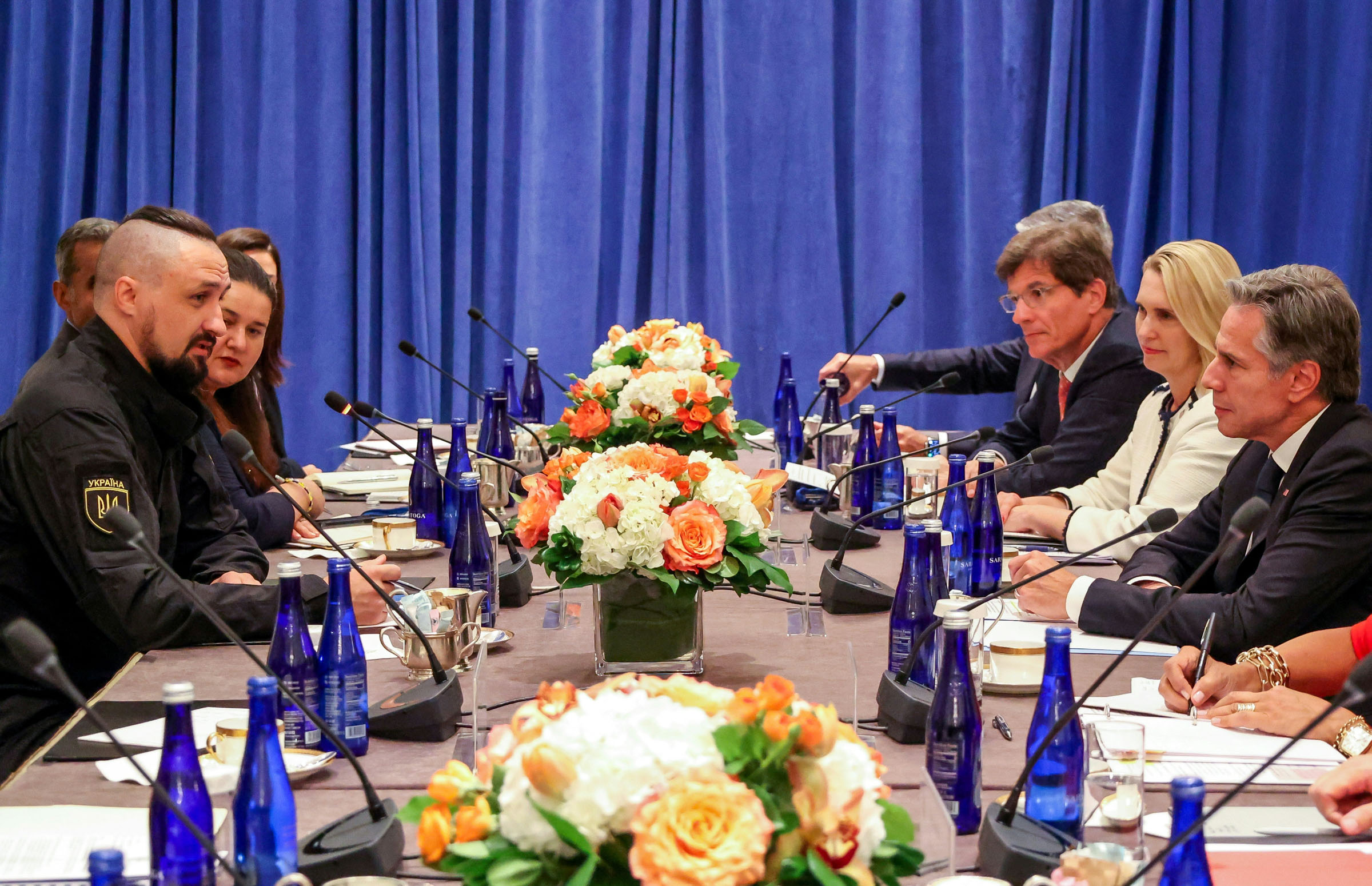
During a tour of the station in Kyiv, Kamyshin invited me to inspect a passenger train that a group of workers had just finished cleaning. He walked into one of the sleeper cars, looked around and ran his fingers over a luggage rack. It was covered in dust. “Does that look clean to you,” he asked one of the elderly managers, who removed his cap and shook his head. Kamyshin then sat the man down for a lecture about the need “to do things in a new way.”
His style of management, and his manner of speaking, borrows a lot from his early career as a banker and auditor, including at KPMG, a global accounting firm whose corporate mumbo-jumbo he still likes to recite from memory. He talks a lot about “following the data.” On more than one occasion, he told me the war has forced Ukraine’s leadership to work under something called “the Tetris principle.” He explained: “All your successes are erased. All your f-ck ups accumulate.” In other words, at a time of war, achievements are taken for granted, while mistakes tend to follow you around.
Even so, during his time as railway boss, Kamyshin earned a lot of respect inside and outside the government for keeping the trains running on time. At least on the surface, that job seemed like a useful dry run for his current mission. Both required him to steer a vast bureaucracy whose managers and equipment date largely to the Soviet Union.
But the weapons industry is far more complicated, says Daria Kaleniuk, a leading activist for good governance in Kyiv. Well before Kamyshin took over the railway company, it underwent reforms to help prevent graft and mismanagement. Few of these changes have been implemented in Ukraine’s military industry. “It is the least reformed sector of our economy,” Kaleniuk says. “It is also the most secretive.”
Before Kamyshin took charge, a series of reformers attempted to clean up Ukraine’s defense sector. Each of them failed. Some blamed a lack of political will at the top. Others pointed to a culture of waste at the bottom. But the fundamental problems with the industry date back to its origins: most of the country’s biggest arms factories were designed and built in the Soviet Union to serve the needs of the Kremlin in Moscow.
In 1991, when the Soviet Union collapsed, Ukraine’s military factories had little choice but to continue selling their products to Russia. For more than two decades, the defense sectors of both countries remained interdependent, often working hand in glove. Russia relied on Ukrainian hardware, including jet engines and ballistic missile technology, while Ukraine’s defense sector relied on its income from these sales to Moscow.
The bonds between them only frayed when Russia launched its first invasion of Ukraine in 2014. That spring and summer, Russian troops occupied the region of Crimea and carved off two separatist enclaves in eastern Ukraine. As the Ukrainians fought back, their weapons industry stopped doing business with the Russians. Many of their production lines were forced to shut down as a result, and their incomes plummeted.
Ukraine’s state arms conglomerate, Ukroboronprom, soon set out to find new partners and customers, especially in the West. “We needed to take this post-Soviet behemoth and turn it into a Western type of company,” says Denys Gurak, who was still in his 20s when he was put in charge of this effort in the summer of 2014. The job, he says, came “by coincidence.” He was friends with the new boss at Ukroboronprom; they had gone to business school together, and Gurak was the only one on their team who spoke fluent English.
Over the next few years, he attempted to implement corporate-governance reforms and build relations with some of the biggest arms manufacturers in the U.S. and Europe. “Most of the time I felt like Don Quixote,” Gurak says. “I probably did about 10% of what I set out to do.” The main obstructions came not from the West, he says, but from the older managers within the system, many of whom had no interest in adapting to the Western market.
“I would call them Russian agents,” Gurak says. Even if they were not on the Kremlin’s payroll, their views aligned with the Soviet ideas of brotherhood between Russia and Ukraine. “We have this stupid kind of corruption where people can be influenced indirectly through post-Soviet culture,” he says. “It doesn’t have to be a direct agent, just a corrupt guy in the system, and his actions ultimately benefit Russia.”
As a result, new policies handed down from the top faced stiff resistance in the lower ranks, and by 2016 the government all but abandoned its attempts to change the system. The Ukrainian president at the time, Petro Poroshenko, blocked key reforms of the arms industry that year, deeming it too sensitive and too secretive to tamper with.
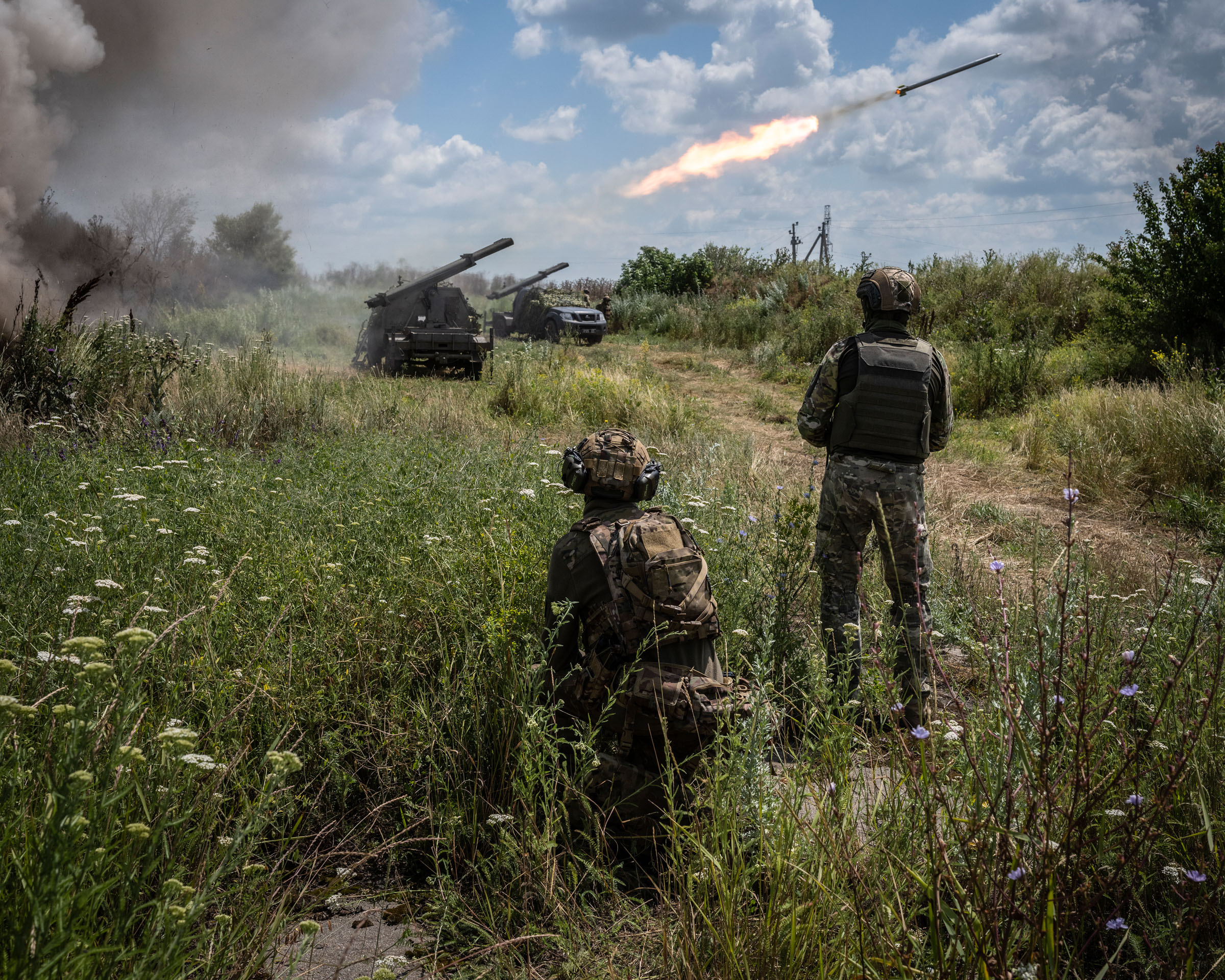
The decision soon came back to haunt Poroshenko. When he ran for re-election two years later, a massive corruption scandal broke out inside the state weapons conglomerate, dealing a blow to the incumbent’s popularity. One of his close associates was implicated in a scheme to smuggle military equipment from Russia and sell it at a mark-up to Ukraine. A few months later, Poroshenko lost the race to a comedian named Zelensky.
As a political outsider, Zelensky ran on a promise to fight corruption, and the defense sector was among his top priorities. But in 2019, when reformers in his administration proposed cleaning out the military industry and radically reducing its workforce, Zelensky got cold feet. It was too big, with some 56,000 employees and many towns reliant on its factories. Instead of closing them down, the Zelensky administration built up a new bureaucracy, the Ministry of Strategic Industries, that would oversee the entire defense sector. It promised to create jobs rather than cutting them, and the state’s attempts to reform the industry then continued to stagnate. Even the full-scale Russian attack did not immediately revive them.
In February 2022, when much of Ukrainian society jumped into action to defend the country, the domestic arms industry continued to sputter, barely producing any artillery shells in the first year of the invasion. A state-owned gunpowder factory went bankrupt in February 2023, weighed down by its debts. The state arms conglomerate, Ukroboronprom, did not even undergo the corporate changes necessary to create a joint venture with a Western firm.
The President’s office did not have much time to deal with these problems at that point. To fight off the Russians, Ukraine needed supplies of weapons fast, and it would take months to squeeze sufficient firepower out of the state’s decaying manufacturers. Instead, the armed forces relied on available stockpiles, both their own and those of their allies, who donated tens of billions of dollars’ worth of weapons to help beat the Russians back.
But, over time, these supplies began drying up, leaving wide gaps in the Ukrainian arsenal. One big problem had to do with mine-trawlers, which the Ukrainians needed at the start of their summer counteroffensive to clear a path through enemy defenses. De-mining equipment from the West arrived too slowly through the spring and early summer. But Kamyshin soon realized these machines were not complicated. They looked like metal claws affixed to the front of an armored vehicle, and teams of Ukrainian welders were soon assigned to start making them as fast as possible.
“It’s not rocket science,” Kamyshin told me. “All these problems come down to being better organized.” Most of the factories he visited were full of workers eager to do their part in the war effort, but their managers often did not understand what the military needs. At one point, Zelensky asked Kamyshin to deal with a backlog of damaged tanks. Ukraine was preparing to send them to Poland to be fixed. But, after a tour of Ukraine’s tank factories and frontline repair points, Kamyshin realized that, with some support, they were perfectly capable of doing the job.
In June 2023, the director of one of those tank factories, Herman Smetanin, who is 31 and looks even younger, was appointed to lead the state weapons conglomerate, Ukroboronprom. He immediately began pushing through the corporate reforms that several of his predecessors had failed to implement. Within a few months, he had turned the state concern into a corporation, capable of partnering with foreign firms, and he began traveling to the U.S. and Europe to negotiate partnerships.
“It’s a new era,” says Olena Tregub, the head of an independent watchdog of the defense sector. Infighting between Ukrainian arms producers and their government bosses had always hampered reforms and innovation. “Now finally they are working as a team,” she says. “Of course it’s difficult. It’s a new sector for Kamyshin. But he’s a very dynamic person, very aggressive in the good sense of the word.”
It sounded strange to hear an activist like Tregub talk this way about a senior minister. Her organization, known as NAKO, conducts oversight of the defense sector with funding from foreign grants and donors, and it does not pull punches in criticizing industry officials. Its reports have ended some of their careers. Yet when it came to Kamyshin and Smetanin, no one I spoke to had serious qualms. Kaleniuk, among the most prominent of Ukraine’s anti-corruption crusaders, told me: “I have no evidence that Kamyshin is corrupt.” Coming from her, this sounded like high praise.

The challenges, to be sure, are enormous. Kamyshin’s ministry has been tasked with reforming a gargantuan system of secret facilities in the middle of an invasion, all while Russian missiles batter its factories from above and Ukrainian security services hunt for enemy agents from within. In May 2022, the state’s main spy agency announced the arrest of a defense sector employee for urging his colleagues to “support the enemy’s army.” In early 2023, an arm of Ukroboronprom saw one of its workers charged with treason for passing military secrets to the Russians.
But all this turmoil can serve as a chance to drive rapid reform, says Abromivicius, who served as acting head of Ukroboronprom at the start of Zelensky’s tenure. “In a country in transition, personalities do matter,” he said. “Someone like Kamyshin understands his sense of purpose. He has authority and autonomy. It’s very important for him to deliver results fast, because the President likes to rely on people who deliver quick wins. Then he will get the support he needs.”
Despite the weight of his responsibility, and the potential consequences if he fails, Kamyshin does not come off as much of a worrier. On numerous occasions, Russia has sought to assassinate key figures in Europe’s military industry, once attempting to poison an arms dealer in Bulgaria whose factories supplied the Ukrainian army. (Ukraine’s military intelligence agency, for its part, has also made public threats to assassinate Russian arms manufacturers.) But Kamyshin still prefers to walk around the streets of Kyiv rather than riding in an armored convoy.
One afternoon last fall, he invited me to visit an art installation in Kyiv, and his bodyguard stayed mostly out of sight. The installation featured a phalanx of imitation drones fashioned out of rusty metal, arranged on the floor like a swarm of robotic insects. Above them loomed a gigantic mother-drone, more than ten feet tall, with a mock bomb dangling from its belly. The artist explained that the work was an homage to the drones killing Russians at the front. But Kamyshin’s mind was elsewhere. “We should mass produce these and sell them,” he said of the replicas. “Then use the money to buy real drones.”
His fixation on these weapons comes down to their efficiency. “It sounds boring,” Kamyshin told me. “But there’s a formula: Cost to kill.” It applies to almost every weapon Ukraine produces. One Stugna missile, for example, kills an average of three enemy soldiers, each at an average price of $4613, Kamyshin says. By comparison, simple drones known as FPVs have a cost-to-kill ratio of around $1650. The disparity led him to a simple conclusion: “You have to pump the maximum amount of money you can into drones.”
Last year, Ukraine invested around a billion dollars into its domestic drone program, and that figure will more than double in 2024. Roughly two hundred firms in Ukraine now produce drones for the military, ranging from start-ups to large, Soviet-era facilities. In the summer of 2016, one of Ukraine’s leading aerospace firms unveiled a drone called the Horlytsia, or Turtledove. It had a modest range of about 100 kilometers and could handle reconnaissance and targeting, both of which are critical in an artillery war.
But, when the Russian invasion began in 2022, Ukraine had just one of these drones available, a prototype. Only in the second year of the invasion were they re-engineered to fly much longer distances and put into mass production. They have since been used to strike targets deep inside Russian territory.
At the same time, Ukraine has appealed for more equipment from Western arms manufacturers like Raytheon and Lockheed Martin. “We found a back door,” Kamyshin says. Rather than asking for the most advanced technology, he looked for ways to reconfigure weapons that the U.S. no longer plans to use. American warehouses were full of such kit. One useful item was an old version of the Sidewinder missile, first produced in the 1950s to allow fighter jets to shoot enemy planes out of the sky. A joint team of engineers and army technicians from the U.S. and Ukraine rigged them to be fired from the ground, creating a cheap air-defense system out of rockets the Americans might otherwise have thrown away. “We have its first flight,” Kamyshin says. “And it will give my country self-made air defense.” During his visit to Davos this month, he announced that these weapons had been used for the first time to shoot down a Russian attack drone.
Still, Zelensky and his team understand the war cannot be won with hand-me-downs. To defeat an enemy as massive and technologically advanced as Russia, Ukraine will need access to Western arms, including highly classified blueprints and maintenance manuals for heavy weaponry. No private firm in the U.S. or Europe can share such secrets without government permission, and Zelensky has been pleading with Biden to grant it.
But here, too, the powers of the White House are limited, particularly when it comes to more advanced technology. “We have tight restrictions on what kind of technical know-how can be shared,” says Jana del-Cerro, who worked until 2022 at the branch of the State Department that enforces these restrictions.
The U.S. President can try to hurry approval by declaring the request an emergency. But, under U.S. law, it would still need clearance from an alphabet soup of authorities inside the Departments of State, Commerce and Defense, among others. “There’s no button anyone can push to fast-track these things,” says del-Cerro, now a partner at the law firm Crowell & Moring in Washington.
At this stage of the war, Ukraine does not have the licenses to repair the American weapons it has received, let alone produce them. John Ullrich, an executive at Raytheon Technologies, compares it to giving your friends a car but not allowing them to change the motor oil. Earlier in his career, Ullrich worked on the production of the Javelin missile, a shoulder-fired tank killer that costs roughly a quarter million dollars per shot. The U.S. delivered thousands of them to Ukraine early in the invasion, and they were critical to Russia’s defeat in the Battle of Kyiv.
But now, Ullrich says, Ukraine needs access to more advanced technology, as well as the money to use it and adapt it to the changing realities on the battlefield. “That war will be won in a factory,” he told me. “It’s a war of attrition.”
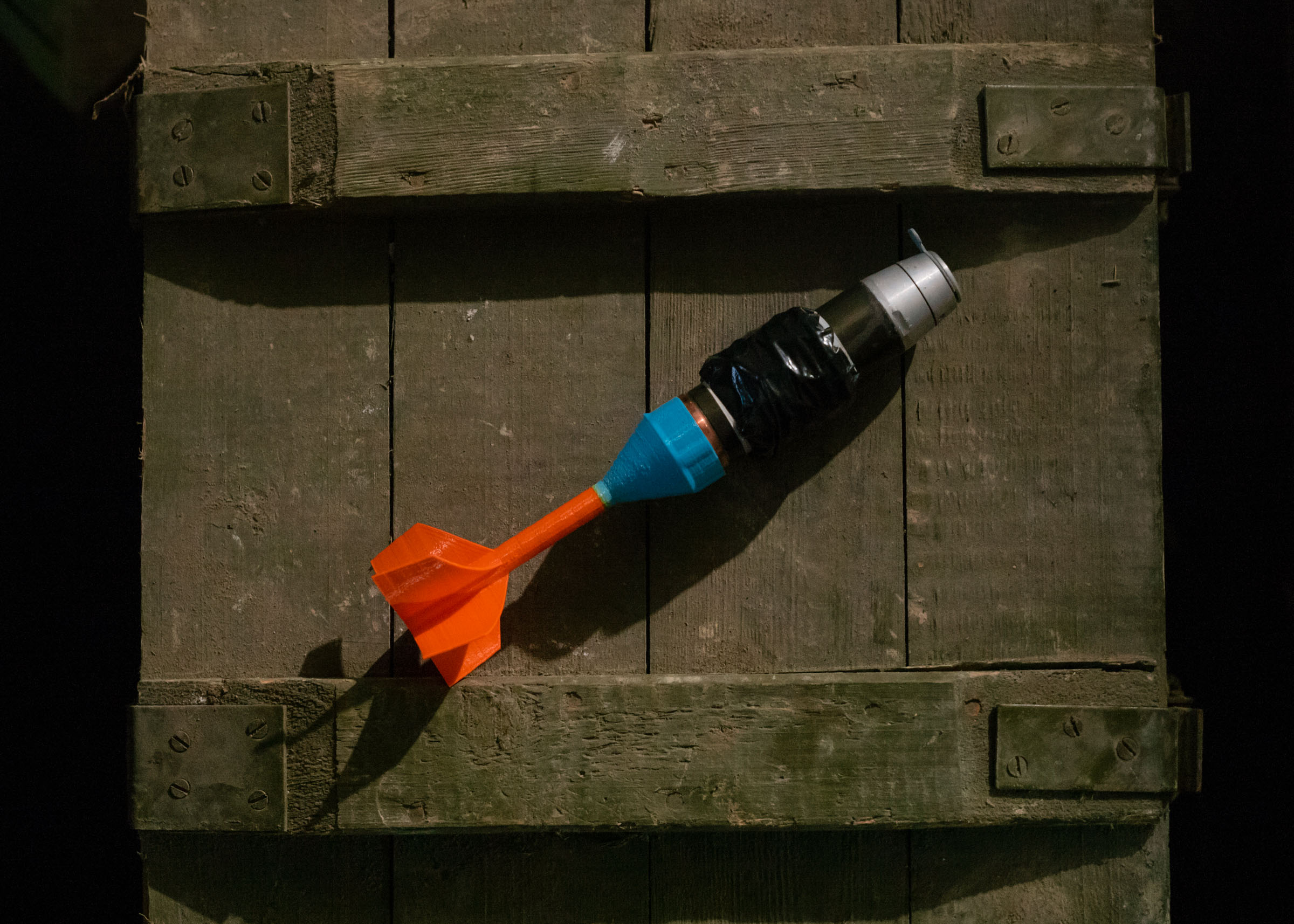
In the middle of December, when we last spoke at length on the phone, Kamyshin had just returned home after a long visit to Washington. The previous night, Russia had launched a barrage of missiles at Kyiv. Ukraine’s air-defense systems shot them down, but the burning debris rained down over the capital, starting fires, damaging a children’s hospital, and wounding at least 53 people. Several facilities from the military industry sustained damage, and Kamyshin made the rounds to see how quickly they could be repaired.
Throughout the year, he has tried to make weapons factories more resilient to such attacks. Many of Ukraine’s arms producers are located near the frontlines, where they are vulnerable to Russian artillery fire and aerial bombardment. Instead of moving these factories farther to the west, where their workers and equipment could be more easily protected, Kamyshin decided to “duplicate” them, setting up multiple production lines in different parts of the country. “You pull off a branch, you plant it elsewhere and nurture it,” he says. “But the trunk keeps growing.”
When I asked about the outcome of his trip to Washington, he did not dwell on his meetings at the White House and on Capitol Hill, where Republicans were holding up an aid package worth around $60 billion for Ukraine. He focused instead on his talks with the private sector. Top executives from the biggest firms in the U.S. defense industry had come to meet with him and Zelensky in Washington last month. “The combined revenue of those companies is bigger than Ukraine’s entire GDP,” says Kamyshin, who sat beside Zelensky at the meeting. “They all showed up, and they all wanted to help.”
The previous week, dozens of other potential investors came to a landmark forum at the Commerce Department, where Defense Secretary Lloyd Austin called on “the full might of American industry” to help Ukraine win the war. On the sidelines, Kamyshin and his team grabbed every chance to convince U.S. executives of the value of working in Ukraine. “It’s about reputation,” his deputy, Anna Gvozdiar, told me in summarizing one of her arguments. “If you are a big defense company, you need to be in Ukraine, because all the eyes of the world are watching this war.”
In private meetings, Kamyshin tried to sell Ukraine’s defense sector as an investor’s Shangri-La, with a cheap and motivated workforce, flexible regulations, and the ability to test new weapons in combat as soon as they roll off the line. Some companies saw the potential. Aaron Starks, the head of a trade organization called 47G, which represents the aerospace, defense and cyber industries in Utah, signed a cooperation deal with Kamyshin and made a trip to Kyiv to scout opportunities last fall. “From a business perspective,” Starks told me, “Ukraine represents one of the hottest defense technology innovation hubs in the world right now.”
But the Western giants of the industry have been slow to take the plunge. The first was Germany’s Rheinmetall, which has announced plans to build a factory in Ukraine, aiming to start production of armored vehicles next year. BAE Systems, the biggest arms manufacturer in the U.K., has opened a representative office in Kyiv, though it is still in the process of staffing it.
The risks can seem daunting. There is no insurance policy against a Russian missile strike in Ukraine, and no way of knowing for sure how the Ukrainians will manage the trade secrets of their foreign partners. To access those secrets, including the blueprints needed to build and maintain new weapons systems, they need more than the U.S. government’s permission. They also need their foreign partners to trust Ukraine with those secrets. That kind of trust takes time to build, and Kamyshin is just starting to lay its foundations, one pitch meeting at a time.
More Must-Reads from TIME
- L.A. Fires Show Reality of 1.5°C of Warming
- How Canada Fell Out of Love With Trudeau
- Trump Is Treating the Globe Like a Monopoly Board
- Bad Bunny On Heartbreak and New Album
- 10 Boundaries Therapists Want You to Set in the New Year
- The Motivational Trick That Makes You Exercise Harder
- Nicole Kidman Is a Pure Pleasure to Watch in Babygirl
- Column: Jimmy Carter’s Global Legacy Was Moral Clarity
Contact us at letters@time.com
